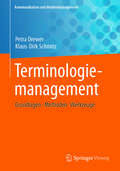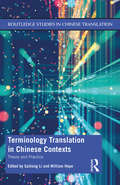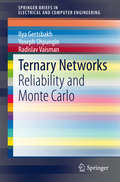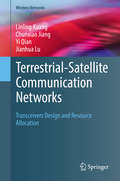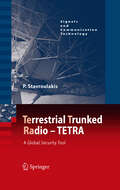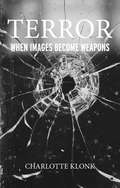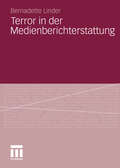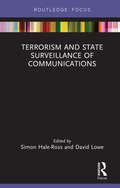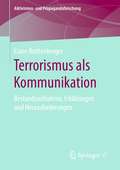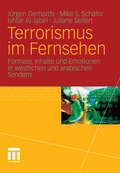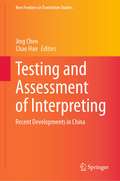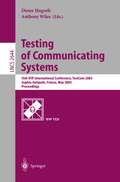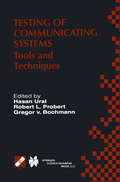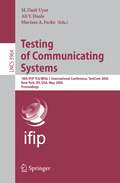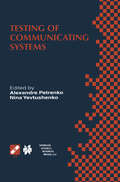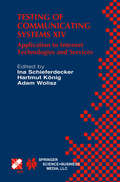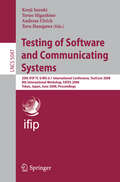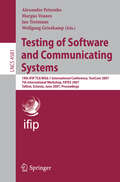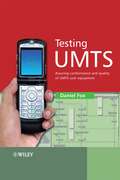- Table View
- List View
Terminologiemanagement: Grundlagen - Methoden - Werkzeuge (Kommunikation und Medienmanagement)
by Petra Drewer Klaus-Dirk SchmitzDieses Buch hilft Unternehmen und Organisationen bei der Konzeption und Implementierung von Terminologiemanagementlösungen. Es stellt dar, wie Fachwortschätze professionell erarbeitet, bereinigt und verwaltet werden – Grundvoraussetzung für den Aufbau einer Corporate Language. Darüber hinaus zeigen die Autoren, wie Terminologiemanagementprozesse sinnvoll in die ein- und mehrsprachige Dokumentationserstellung eingebunden werden können.
Terminology Translation in Chinese Contexts: Theory and Practice (Routledge Studies in Chinese Translation)
by Saihong Li William HopeTerminology Translation in Chinese Contexts: Theory and Practice investigates the theory and practice of terminology translation, terminology management, and scholarship within the distinctive milieu of Chinese and explores the complex relationship between terminology translation (micro level) and terminology management (macro level). This book outlines the contemporary challenges of terminology translation and terminology management within Chinese contexts in specialized fields including law, the arts, religion, Chinese medicine, and food products. The volume also examines how the development and application of new technologies such as big data, cloud computing, and artificial intelligence have brought about major changes in the language service industry. Technology such as machine translation and computer-assisted translation has spawned new challenges in terminology management practices and has facilitated their evolution in contexts of ever greater internationalization and globalization. This book recontextualizes terminology translation and terminology management with a special focus on English–Chinese translation. It is hoped that the volume will enable and enhance dialogue between Chinese and Western scholars and professionals in the field. All chapters have been written by specialists in the different subfields and have been peer-reviewed by the editors.
Terminology Translation in Chinese Contexts: Theory and Practice (Routledge Studies in Chinese Translation)
by Saihong Li William HopeTerminology Translation in Chinese Contexts: Theory and Practice investigates the theory and practice of terminology translation, terminology management, and scholarship within the distinctive milieu of Chinese and explores the complex relationship between terminology translation (micro level) and terminology management (macro level). This book outlines the contemporary challenges of terminology translation and terminology management within Chinese contexts in specialized fields including law, the arts, religion, Chinese medicine, and food products. The volume also examines how the development and application of new technologies such as big data, cloud computing, and artificial intelligence have brought about major changes in the language service industry. Technology such as machine translation and computer-assisted translation has spawned new challenges in terminology management practices and has facilitated their evolution in contexts of ever greater internationalization and globalization. This book recontextualizes terminology translation and terminology management with a special focus on English–Chinese translation. It is hoped that the volume will enable and enhance dialogue between Chinese and Western scholars and professionals in the field. All chapters have been written by specialists in the different subfields and have been peer-reviewed by the editors.
Ternary Networks: Reliability and Monte Carlo (SpringerBriefs in Electrical and Computer Engineering)
by Ilya Gertsbakh Yoseph Shpungin Radislav VaismanTernary means “based on three”. This book deals with reliability investigations of networks whose components subject to failures can be in three states –up, down and middle (mid), contrary to traditionally considered networks having only binary (up/down) components. Extending binary case to ternary allows to consider more realistic and flexible models for communication, flow and supply networks
Terrestrial-Satellite Communication Networks: Transceivers Design and Resource Allocation (Wireless Networks)
by Linling Kuang Chunxiao Jiang Yi Qian Jianhua LuThis book targets major issues in terrestrial-satellite communication networks and presents the solutions. While the terrestrial networks can achieve high-speed data service at low cost, satellite based access is one way to complement terrestrial based networks to ensure ubiquitous, 100% geographic coverage. The coexistence and cooperation between terrestrial and satellite networks are of great potential in future communication networks, and satellite radio access networks has already been considered in the fifth-generation (5G) networks to be supported for phase 2. Therefore, it is important to study the architectures of terrestrial-satellite networks, as well as the possible techniques and challenges. The authors introduce the technique of beamforming in satellite communication systems, which is an efficient transmitting method for multiple access, and they discuss the main challenges as well as prospective applications. The authors introduce possible methods for interference cancelation reception in terrestrial-satellite communication networks when reusing the frequency band between the two networks. Due to the limitation of spectrum resources, spectrum sharing will become one of the important issues in terrestrial-satellite communication networks. The problems of spectrum coexistence between GEO and Terrestrial Systems and between GEO and NEGO systems are also discussed. Finally, taking both the two system into consideration, the resource allocation problem will be more complex due to the coupling between resources and the interference. Based on this, the authors propose several resource allocation schemes in different scenarios of terrestrial-satellite communication networks, which can optimize the capacity performance of the system. The expected audience for this book includes (but not limited to) graduate students, professors, researchers, scientists, practitioners, engineers, industry managers, and government researchers working in the field of satellite communications and networks.The expected audience for this book includes (but not limited to) graduate students, professors, researchers, scientists, practitioners, engineers, industry managers, and government researchers working in the field of satellite communications and networks.
TErrestrial Trunked RAdio - TETRA: A Global Security Tool (Signals and Communication Technology)
by Peter StavroulakisTerrestrial Trunked Radio (TETRA) has become the tool to design any type of public security systems, in particular due to the strongly increased security demands for mobile systems. In this book, the authors show how TETRA can be strongly improved and these improvements will most probably be part of future TETRA standards. The areas examined include channel assignment and multiple access techniques, video transmission, wireless LAN integration, and the establishment of multiple wireless mesh networks. Since the requirements for these networks is security, the authors show that innovative techniques such as those based on chaotic signals can be used in order to maximize security. The book is a vital reference point for researchers with ambition to find the general solution for modern problems of public safety.
Terror: When images become weapons
by Charlotte KlonkIn June 2016, a French policeman was stabbed to death in a Paris suburb. His assailant gained access to the victim’s flat, where he murdered the policeman’s partner in front of their three-year-old son. While negotiating with members of the special forces, the murderer posted live footage of himself and his victims on Facebook. Acting in the name of the so-called Islamic State, the perpetrator, who would later be shot and killed, single-handedly applied one of the fundamental tenets of modern terrorism: it is not the act of violence itself that counts, but the images of it that are brought into circulation. Once released, nothing and no one can eradicate these images and the visual battle that ensues knows no winners or ceasefire. With the expert eye of an art historian, Charlotte Klonk documents the visual machinery of terrorism from the late nineteenth century to the present day. She shows that the propaganda videos form the IS are nothing new. On the contrary, perpetrators of terror acts have always made use of images to spread their cause through the media – as have their enemy, the state. This is an indispensable book for understanding the background and dynamic of terror today.
Terror: When images become weapons
by Charlotte KlonkIn June 2016, a French policeman was stabbed to death in a Paris suburb. His assailant gained access to the victim’s flat, where he murdered the policeman’s partner in front of their three-year-old son. While negotiating with members of the special forces, the murderer posted live footage of himself and his victims on Facebook. Acting in the name of the so-called Islamic State, the perpetrator, who would later be shot and killed, single-handedly applied one of the fundamental tenets of modern terrorism: it is not the act of violence itself that counts, but the images of it that are brought into circulation. Once released, nothing and no one can eradicate these images and the visual battle that ensues knows no winners or ceasefire. With the expert eye of an art historian, Charlotte Klonk documents the visual machinery of terrorism from the late nineteenth century to the present day. She shows that the propaganda videos form the IS are nothing new. On the contrary, perpetrators of terror acts have always made use of images to spread their cause through the media – as have their enemy, the state. This is an indispensable book for understanding the background and dynamic of terror today.
Terrorism and State Surveillance of Communications
by Simon Hale-Ross David LoweThis book brings together leading counterterrorism experts, from academia and practice, to form an interdisciplinary assessment of the terrorist threat facing the United Kingdom and the European Union, focusing on how terrorists and terrorist organisations communicate in the digital age. Perspectives drawn from criminological, legalistic, and political sciences, allow the book to highlight the problems faced by the state and law enforcement agencies in monitoring, accessing, and gathering intelligence from the terrorist use of electronic communications, and how such powers are used proportionately and balanced with human rights law. The book will be a valuable resource for scholars and students of terrorism and security, policing and human rights. With contributions from the fields of both academia and practice, it will also be of interest to professionals and practitioners working in the areas of criminal law, human rights and terrorism.
Terrorism and State Surveillance of Communications
by Simon Hale-Ross David LoweThis book brings together leading counterterrorism experts, from academia and practice, to form an interdisciplinary assessment of the terrorist threat facing the United Kingdom and the European Union, focusing on how terrorists and terrorist organisations communicate in the digital age. Perspectives drawn from criminological, legalistic, and political sciences, allow the book to highlight the problems faced by the state and law enforcement agencies in monitoring, accessing, and gathering intelligence from the terrorist use of electronic communications, and how such powers are used proportionately and balanced with human rights law. The book will be a valuable resource for scholars and students of terrorism and security, policing and human rights. With contributions from the fields of both academia and practice, it will also be of interest to professionals and practitioners working in the areas of criminal law, human rights and terrorism.
Terrorismus als Kommunikation: Bestandsaufnahme, Erklärungen und Herausforderungen (Aktivismus- und Propagandaforschung)
by Liane RothenbergerKommunikationstheorien und Terrorismus – wie lässt sich hier eine Verbindung schaffen? Terrorismus ist ein in der heutigen Zeit dominantes Thema: Es bestimmt zuweilen die öffentliche politische Diskussion wie auch private Gespräche. Die Kommunikationswissenschaft kann dazu beitragen, das Phänomen Terrorismus weiter zu durchdringen, und wichtige Puzzlesteine liefern, es in seiner Gesamtheit zu erfassen. Die Entwicklung der Medienkompetenz mancher Terroristengruppen drängt es geradezu auf, das „Gesellschaftsproblem Terrorismus“ mithilfe einer „kommunikationswissenschaftlichen Brille“ anzugehen.
Terrorismus im Fernsehen: Formate, Inhalte und Emotionen in westlichen und arabischen Sendern
by Jürgen Gerhards Mike S. Schäfer Ishtar Al Jabiri Juliane SeifertOhne die Berichterstattung der Massenmedien würden die meisten Menschen kaum etwas über terroristische Anschläge erfahren. Allerdings können Medien derartige Anschläge sehr unterschiedlich darstellen. Die Studie vergleicht die Terrorismusberichterstattung von fünf Fernsehsendern aus unterschiedlichen Ländern und Weltregionen: CNN, Al Jazeera, BBC, ARD und RTL. Untersucht werden die Formate der Berichterstattung, die inhaltlichen Deutungen der Anschläge und die damit verbundenen Emotionsdarstellungen. Vorgefundene Unterschiede und Gemeinsamkeiten werden u.a. mit Hilfe von Globalisierungstheorien und Theorien kultureller Unterschiede interpretiert.
Testing and Assessment of Interpreting: Recent Developments in China (New Frontiers in Translation Studies)
by Jing Chen Chao HanThis book highlights reliable, valid and practical testing and assessment of interpreting, presenting important developments in China, where testing and assessment have long been a major concern for interpreting educators and researchers, but have remained largely under-reported. The book not only offers theoretical insights into potential issues and problems undermining interpreting assessment, but also describes useful measurement models to address such concerns. Showcasing the latest Chinese research to create rubrics-referenced rating scales, enhance formative assessment practice, and explore (semi-)automated assessment, the book is a valuable resource for educators, trainers and researchers, enabling to gain a better understanding of interpreting testing and assessment as both a worthwhile endeavor and a promising research area.
Testing and Diagnosis of VLSI and ULSI (NATO Science Series E: #151)
by F. Lombardi M. G. SamiThis volume contains a collection of papers presented at the NATO Advanced Study Institute on ·Testing and Diagnosis of VLSI and ULSI" held at Villa Olmo, Como (Italy) June 22 -July 3,1987. High Density technologies such as Very-Large Scale Integration (VLSI), Wafer Scale Integration (WSI) and the not-so-far promises of Ultra-Large Scale Integration (ULSI), have exasperated the problema associated with the testing and diagnosis of these devices and systema. Traditional techniques are fast becoming obsolete due to unique requirements such as limited controllability and observability, increasing execution complexity for test vector generation and high cost of fault simulation, to mention just a few. New approaches are imperative to achieve the highly sought goal of the • three months· turn around cycle time for a state-of-the-art computer chip. The importance of testing and diagnostic processes is of primary importance if costs must be kept at acceptable levels. The objective of this NATO-ASI was to present, analyze and discuss the various facets of testing and diagnosis with respect to both theory and practice. The contents of this volume reflect the diversity of approaches currently available to reduce test and diagnosis time. These approaches are described in a concise, yet clear way by renowned experts of the field. Their contributions are aimed at a wide readership: the uninitiated researcher will find the tutorial chapters very rewarding. The expert wiII be introduced to advanced techniques in a very comprehensive manner.
Testing of Communicating Systems: 15th IFIP International Conference, TestCom 2003, Sophia Antipolis, France, May 26-28, 2003, Proceedings (Lecture Notes in Computer Science #2644)
by Dieter Hogrefe Anthony WilesTesting of Communicating Systems: Tools and Techniques. IFIP TC6/WG6.1 13th International Conference on Testing of Communicating Systems (TestCom 2000), August 29–September 1, 2000, Ottawa, Canada (IFIP Advances in Information and Communication Technology #48)
by Hasan Ural Gregor Von Bochmann Robert L ProbertTesting of Communicating Systems presents the latest international results in both the theory and industrial practice of the testing of communicating systems. The topics discussed range from tools and techniques for testing to test standards, frameworks, notations, algorithms, fundamentals of testing, and industrial experiences and issues. The tools and techniques discussed apply to conformance testing, interoperability testing, performance testing of communications software, Internet protocols and applications, and multimedia and distributed systems in general, such as systems for electronic commerce. This volume contains the extensively refereed proceedings of the 13th International Conference on Testing of Communicating Systems (TestCom 2000), which was sponsored by the International Federation for Information Processing (IFIP) and held in Ottawa, Ontario, Canada in early September 2000. Testing of Communicating Systems is essential reading for engineers, designers, managers of IT products and services, and all researchers interested in advancing the technology of engineering Internet frameworks, systems, services, and applications for reliability and quality.
Testing of Communicating Systems: 18th IFIP TC 6/WG 6.1 International Conference, TestCom 2006, New York, NY, USA, May 16-18, 2006, Proceedings (Lecture Notes in Computer Science #3964)
by M. Ümit Uyar Ali Y. Duale Mariusz A. FeckoThis book constitutes the refereed proceedings of the 18th IFIP TC 6/WG 6.1 International Conference on Testing Communicating Systems, TestCom 2006. The 23 revised full papers presented were carefully reviewed and selected from initially 48 submissions. The papers address all current issues in testing communicating systems, ranging from classical telecommunication issues to general software testing.
Testing of Communicating Systems: Proceedings of the IFIP TC6 11th International Workshop on Testing of Communicating Systems (IWTCS’98) August 31-September 2, 1998, Tomsk, Russia (IFIP Advances in Information and Communication Technology #3)
by Nina YevtushenkoTesting of Communicating Systems presents the latest world-wide results in both theory and practice. This volume provides a forum in which the substantial volume of research on the testing of communicating systems, spanning from conformance testing through interoperability testing, to performance and QoS testing, is brought together. The following topics are discussed in detail: Types of testing; Phases of the testing process; Classes of systems to be tested; and Theory and practice of testing. This book contains the selected proceedings of the 11th International Workshop on the Testing of Communicating Systems, formerly the International Workshop on Protocol Test Systems, sponsored by the International Federation for Information Processing (IFIP), and held in Tomsk, Russia, in August/September 1998. Testing of Communicating Systems will be essential reading for engineers, IT managers and research personnel working in computer sciences and telecommunications.
Testing of Communicating Systems XIV: Application to Internet Technologies and Services (IFIP Advances in Information and Communication Technology #82)
by Ina Schieferdecker Hartmut König Adam WoliszTesting of Communicating Systems XIV presents the latest international results in both the theory and industrial practice of the testing of communicating systems, ranging from tools and techniques for testing to test standards, frameworks, notations, algorithms, fundamentals of testing, and industrial experiences and issues. The tools and techniques discussed apply to conformance testing, interoperability testing, performance testing, Internet protocols and applications, and multimedia and distributed systems in general.
Testing of Software and Communicating Systems: 20th IFIP TC 6/WG 6.1 International Conference, TestCom 2008 8th International Workshop, FATES 2008, Tokyo, Japan, June 10-13, 2008 Proceedings (Lecture Notes in Computer Science #5047)
by Kenji Suzuki Teruo Higashino Andreas Ulrich Toru HasegawaThis book constitutes the refereed proceedings of the 20th IFIP TC 6/WG 6.1 International Conference on Testing Communicating Systems, TestCom 2008, and the 8th International Workshop on Formal Approaches to Testing of Software, FATES 2008, jointly held in Tokyo, Japan, in June 2008. The 18 revised full papers presented together with 2 invited talks were carefully reviewed and selected from initially 58 submissions to both events. The papers cover new approaches, concepts, theories, methodologies, tools, and experiences in the field of testing of communicating systems and general software. They are organized in topical sections on general software testing, testing continuous and real-time systems, network testing, test generation, concurrent system testing, and applications of testing.
Testing of Software and Communicating Systems: 19th IFIP TC 6/WG 6.1 International Conference, TestCom 2007, 7th International Workshop, FATES 2007, Tallin, Estonia, June 26-29, 2007, Proceedings (Lecture Notes in Computer Science #4581)
by Margus Veanes Jan Tretmans Wolfgang GrieskampThis book constitutes the refereed proceedings of the 19th IFIP TC 6/WG 6.1 International Conference on Testing Communicating Systems, TestCom 2007, and the 7th International Workshop on Formal Approaches to Testing of Software, FATES 2007, held in Tallinn, Estonia. It covers all current issues in testing communicating systems and formal approaches in testing of software, from classical telecommunication issues to general software testing.
Testing UMTS: Assuring Conformance and Quality of UMTS User Equipment
by Daniel FoxA modern mobile phone is a highly complex electronic system made up from a variety of diverse sub-systems, all of which must work seamlessly together. Today's users have very high expectations which set tough demands on manufacturers as they introduce third generation technology. While quality, in terms of the phone's stability, performance and behaviour on the network, originate from good design, the only way to be sure of quality is by testing it. This makes testing a very important part of any mobile phone's life cycle, from development through to manufacture and beyond, touching a number of different disciplines and departments. Testing UMTS is divided in three sections. Section One provides an overview of major types of testing and the organisations and tasks involved. In particular it looks at what is involved in conformance testing and device certification. Section Two is more technical and looks at the UMTS standard itself, working through the protocol layers. Future trends and their impact on testing mobile devices are examined in Section Three, including the emergence of new technologies both in the access network and the core network and the evolution of new testing methodologies. Examines UMTS and the testing of UMTS devices which are huge areas in the testing process Provides essential information on processes and techniques for mobile phone testing Operation of the UMTS standard is described from a test point of view Focuses on most important areas of the 3rd-Generation Partnership Project (3GPP) standard from a test perspective Offers advice on products, services and resources that aid the testing process. This book is an ideal text for engineers and managers who are either directly involved in the process of testing UMTS mobiles, or who are looking for an understanding of what is involved in testing. Professionals involved in the development of UMTS mobiles, integration and verification, conformance testing, operator acceptance testing, manufacturing and servicing will find this book indispensable.
Text Alignment (large print)
by RnibThis page shows four examples of text alignment: left aligned, centred, right aligned and fully justified. There is a locator dot shown, which will be at the top left of the page when the image is the right way up. Left aligned text is shown in the top left quarter of the page; centred in the top right; right aligned at the bottom left and justified at the bottom right. Each example is labelled and has a short description.
Text Alignment (UEB contracted)
by RnibThis page shows four examples of text alignment: left aligned, centred, right aligned and fully justified. There is a locator dot shown, which will be at the top left of the page when the image is the right way up. Left aligned text is shown in the top left quarter of the page; centred in the top right; right aligned at the bottom left and justified at the bottom right. Each example is labelled and has a short description.
